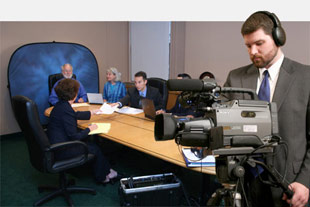High-Resolution Legal Videography for Accurate Evidence Recording.
Why Legal Videography Is Necessary for Accurate Legal Record-Keeping
In the realm of legal proceedings, the precision of record-keeping is critical, and legal videography emerges as an important tool in this context. As we check out the complex advantages of legal videography, one have to consider its implications for the future of judicial integrity and openness.
Significance of Visual Evidence
Establishing the importance of visual evidence in lawful proceedings is vital for ensuring accurate record-keeping and enhancing the general integrity of the judicial procedure. Visual evidence offers as a vital device in documenting occasions, conditions, and various other significant details that may be vital to a case. Unlike created accounts, which are prone to interpretation and prejudice, aesthetic recordings offer an objective, unalterable depiction of truths as they took place.


This form of proof can capture a range of components, consisting of witness actions, environmental context, and physical proof, all of which might influence judicial results. By presenting a clear and extensive aesthetic narrative, lawful videography gets rid of ambiguity and assists to preserve the credibility of the evidence.
Moreover, visual proof can be critical in lowering disputes over factual inconsistencies, as it permits a straight comparison against testament and other recorded records. In an age where electronic modern technology is increasingly common, the capacity to existing visual evidence efficiently can significantly enhance the general high quality of lawful process. Ultimately, the consolidation of aesthetic proof not just bolsters the documentation process however additionally enhances public rely on the judicial system by advertising openness and accountability.
Enhancing Statement Integrity
The assimilation of lawful videography right into court room process dramatically boosts the reliability of witness testimony. By recording the subtleties of verbal and non-verbal communication, video clip recordings supply a more extensive representation of a witness's demeanor, feelings, and dependability. This visual documents enables jurors to observe the witness's body language, facial expressions, and total presence, which are important elements that can influence their assumption of statement reliability.
Furthermore, lawful videography decreases the potential for false impression or distortion of statement that might happen in written records. Audiences can see and listen to the testimony as it existed, guaranteeing that the context and tone are preserved. This authenticity cultivates a higher feeling of count on amongst jurors, who might be a lot more likely to believe testimony that they can witness firsthand.
Additionally, the presence of video clip footage can hinder witnesses from providing misleading or exaggerated statements, as they are aware that their statement is being recorded. This responsibility enhances the stability of the judicial procedure. Eventually, legal videography acts as an essential tool in making certain that witness testimony is not only properly depicted however additionally viewed with increased credibility by all parties included.
Comprehensive Document Conservation
Comprehensive record preservation is necessary for keeping the integrity of legal procedures. Lawful videography functions as an important device in this procedure, giving view it now an accurate visual and auditory account of statements, depositions, and other zero hours in a situation. Unlike traditional written records, video clip recordings record the subtleties of body movement, tone, and feeling, which are essential for understanding the context and intent behind statements made during legal proceedings.

Furthermore, the capacity straight from the source to assess video clip evidence allows attorneys to recognize vital details that may have been overlooked in composed documents. By maintaining a thorough archive of legal proceedings through videography, law companies can maintain the highest criteria of accuracy and accountability, eventually contributing to a fairer judicial process.
Simplifying Lawful Procedures
Enhancing legal process is important for enhancing effectiveness and decreasing delays within the judicial system. Legal videography acts as a critical device in attaining this goal by providing clear and precise aesthetic documents of court hearings, depositions, and testimonies. This innovation permits for real-time recording, making certain that all spoken and non-verbal cues are captured, which can facilitate quicker resolution of conflicts.
The integration of videography into lawful processes reduces dependence on traditional approaches, such as prolonged records, which can be time-consuming to create and examine. By having access to recorded video, lawyers can promptly reference crucial moments, boosting their ability to prepare and existing cases effectively. This immediacy likewise aids in the making clear of testimonies, lowering the capacity for false impression.
Furthermore, aesthetic documentation promotes a more interesting court room experience for jurors, helping them to grasp complicated information quicker. Eventually, lawful videography streamlines interaction among all events entailed, from attorneys to courts to jurors, thereby advertising a much more reliable judicial procedure (legal videography). In an era where time is important, embracing this technology is essential for the modern legal landscape
Admissibility in Court
Accurate paperwork is important not only for performance but also for making sure that evidence is admissible in court. Legal videography offers as an important device in this process, offering a trusted aesthetic document of testimonies, statements, and occasions.
To be regarded acceptable, lawful videography should stick to established protocols, such as proper devices use, proper illumination, and clear audio capture. Furthermore, it is important to have actually qualified videographers who understand continue reading this the legal requirements surrounding proof collection. The chain of guardianship have to additionally be maintained to stop any kind of cases of tampering or alteration.
Additionally, legal videography can enhance the persuasiveness of evidence by supplying jurors with a straight view of the testament, allowing for a much more engaged understanding of the instance. In summary, the assimilation of lawful videography right into record-keeping not just sustains efficiency yet likewise boosts the integrity and admissibility of proof in court process.
Conclusion
In verdict, lawful videography plays a pivotal duty in making certain exact legal record-keeping by offering objective aesthetic documents. Eventually, the consolidation of legal videography right into the judicial procedure promotes transparency and strengthens public depend on in the stability of the legal system.